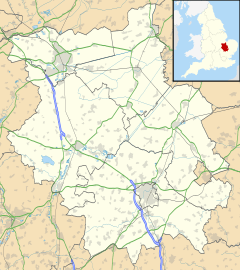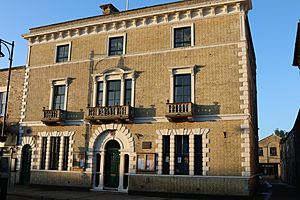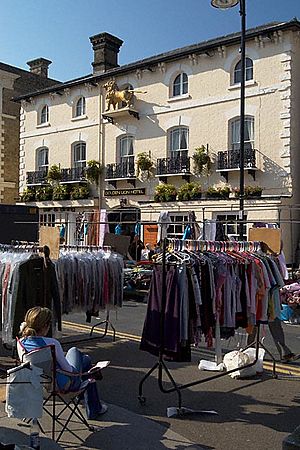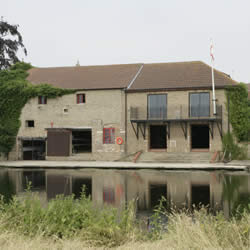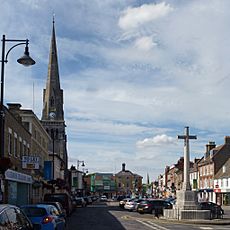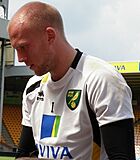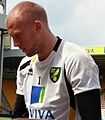St Ives, Cambridgeshire facts for kids
Quick facts for kids St Ives |
|
|---|---|
 Crown Street |
|
| Area | 10.88 km2 (4.20 sq mi) |
| Population | 16,815 (2021 Census) |
| • Density | 1,545/km2 (4,000/sq mi) |
| OS grid reference | TL305725 |
| • London | 90 km (56 mi) South |
| District | |
| Shire county | |
| Region | |
| Country | England |
| Sovereign state | United Kingdom |
| Post town | ST. IVES |
| Postcode district | PE27 |
| Dialling code | 01480 |
| Police | Cambridgeshire |
| Fire | Cambridgeshire |
| Ambulance | East of England |
| EU Parliament | East of England |
| UK Parliament |
|
St Ives is a lively market town and civil parish in Cambridgeshire, England. It is located about 5 miles (8 km) east of Huntingdon and 12 miles (19 km) north-west of Cambridge. St Ives has a long and interesting history, and it was once part of the historic county of Huntingdonshire.
Contents
- What is the History of St Ives?
- How is St Ives Governed?
- What is the Geography of St Ives Like?
- How Has the Population of St Ives Changed?
- What is the Economy of St Ives Like?
- Famous Pubs and Inns in St Ives
- What are the Main Landmarks in St Ives?
- What is the Culture of St Ives Like?
- What About Education in St Ives?
- What Media is Available in St Ives?
- How Do People Get Around in St Ives?
- What Religious Sites are in St Ives?
- Who are Some Famous People from St Ives?
- Images for kids
- See also
What is the History of St Ives?
How St Ives Got Its Name
Long ago, this town was called Slepe during the Anglo-Saxon period. Around the year 1001, a farmer found the remains of a holy man named Ivo of Ramsey while working in his field. Ivo was a Celtic Christian bishop and hermit from Cornwall.
This discovery led to the founding of Ramsey Abbey by an important monk named Eadnoth the Younger. Because of Saint Ivo, Slepe eventually became known as St Ives.
St Ives in the Domesday Book
In 1086, St Ives (then Slepe) was listed in the Domesday Book, a famous survey of England. It was part of the Hurstingstone area in Huntingdonshire. The survey showed that the town had one manor and 64 households. There were also large areas of farmland, meadows, and woodlands.
A Busy Market Town
Ramsey Abbey became very powerful during the Middle Ages. This helped the local area, and Slepe was given a special permission to become a market town. It quickly grew into one of the biggest markets in the country. Even today, St Ives remains an important market town near The Fens.
Trade and the River Great Ouse
St Ives was built on the banks of the wide River Great Ouse. This made it a key place for trade in East Anglia. The town's old street plan still shows how big and busy it was in medieval times.
The St Ives Bridge was built in the early 15th century, replacing an older crossing. This stone bridge has six arches and is special because it has a chapel built into it. It was one of only four town bridges in England with a chapel.
For a long time, this spot on the Great Ouse was important because it was the last natural place to cross the river before it reached the sea. A natural ford (a shallow place to cross) was used as the foundation for the stone bridge. People had to pay tolls to cross the bridge, especially drovers bringing their animals to market. This helped the town earn money.
Changes in Trade and Transport
From the 1600s to the mid-1800s, St Ives continued to be a busy center for trade and river travel. Many inns were built for merchants, sailors, and drovers. Goods arrived by barges, and livestock rested here before being sent to London's Smithfield Market.
However, things changed when the Cambridge and St Ives branch line railway arrived in the 1840s. Roads also improved. This meant that less and less commercial traffic used the River Great Ouse.
Flooding and Flood Protection
The River Great Ouse at St Ives has flooded several times, including in 1947, 1998, and 2003. To protect the town, major flood defense work was done in 2006-2007. This project cost almost £9 million.
About 500 meters (1,640 feet) of steel walls, covered in brick, were put in place to protect the town. A new public area was also created. Another 750 meters (2,460 feet) of protection on the other side of the river helps Hemingford Grey. These efforts have greatly reduced the risk of flooding.
How is St Ives Governed?
St Ives is a civil parish, which means it has its own town council. The council meets at St Ives Town Hall. It has seventeen councillors, including a Town Mayor and a deputy Town Mayor.
The next level of local government is Huntingdonshire District Council. St Ives is divided into three areas for this council: St Ives East, St Ives South, and St Ives West.
The highest level of local government for St Ives is Cambridgeshire County Council. St Ives is part of the "St Ives" electoral division and has two councillors on the county council.
Changes in County Boundaries
St Ives was historically part of Huntingdonshire until 1965. Then, from 1965 to 1974, it was part of a new county called Huntingdon and Peterborough. In 1974, due to a new law, St Ives became part of Cambridgeshire.
National Government Representation
For the national government, St Ives is in the Huntingdon area. Since 2024, its representative in the House of Commons (the main part of the UK Parliament) has been Ben Obese-Jecty from the Conservative Party.
What is the Geography of St Ives Like?
St Ives was planned out very early in its history, which gave it a large town center. Some of the open spaces were later filled with market stalls that became permanent buildings.
Some shops in the town center still have the same layout as they did in medieval times. They are about one rod wide, which was a standard measurement for building materials. The narrow lanes on the north side of town are thought to follow the paths of old medieval fields. They are slightly S-shaped because of how ploughs used to turn at the end of each field. You can see similar old field boundaries in Warners Park.
How Has the Population of St Ives Changed?
Population Growth Over Time
The population of St Ives has been counted every ten years by the UK census. From 1801 to 1901, the population ranged from 2,099 (in 1801) to 3,572 (in 1851).
Since 1901, a census has been taken every ten years, except for 1941 due to the Second World War. The table below shows how the population has grown significantly over the years.
| Parish | 1911 | 1921 | 1931 | 1951 | 1961 | 1971 | 1981 | 1991 | 2001 | 2011 |
|---|---|---|---|---|---|---|---|---|---|---|
| St Ives | 3,015 | 2,797 | 2,664 | 3,078 | 4,082 | 7,148 | 12,331 | 14,930 | 16,001 | 16,384 |
| All population census figures from report Historic Census figures Cambridgeshire to 2011 by Cambridgeshire Insight. | ||||||||||
In 2011, the parish covered an area of about 2,688 acres (1,088 hectares). The population density was about 3,901 persons per square mile (1,506 persons per square kilometer).
What is the Economy of St Ives Like?
St Ives is well known for its markets. The main market takes over the town center every Monday. It becomes even bigger on Bank Holidays in May and August. There is also a Friday market and a Farmers' Market held on the first and third Saturday of every month.
The Michaelmas Fair is a big event that lasts for three days, starting on the second Monday in October. The town also hosts a carnival, which is the largest public gathering in Huntingdonshire. St Ives has a variety of shops, cafes, and other services for its residents and visitors.
Famous Pubs and Inns in St Ives
St Ives once had many pubs because it was a busy trade center. As livestock sales decreased, so did the need for so many pubs. However, there are still 17 pubs in the town today.
The oldest pub name is the Dolphin, which has been used on the same site for over 300 years. The White Hart is also very old, dating back before 1720. The Nelson's Head and Golden Lion are also historic, though they used to have different names. The Golden Lion was a famous coaching inn in the 1800s. It is even said to have some ghost stories!
What are the Main Landmarks in St Ives?
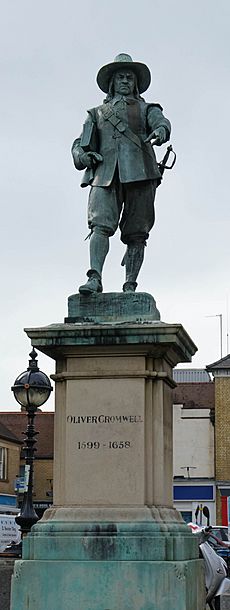
St Ives Bridge
The St Ives Bridge is very special because it has a chapel built into it. This is quite rare, with only four examples like it in England. The two southern arches of the bridge are also unique, as they are rounded instead of having a slightly gothic shape like the others.
After the monasteries were closed down in 1537, the chapel on the bridge was used for many different things. It was a private house, a doctor's office, and even a pub called "Little Hell." This pub was known for being very noisy! In 1930, two extra stories that had been added in the 1600s were removed because they were damaging the bridge's foundations.
The bridge was partly rebuilt after Oliver Cromwell damaged two arches during the English Civil War. He did this to stop King Charles I's troops from reaching London. During the war, a drawbridge covered the gap. In the town square, there is a statue of Oliver Cromwell that was put up in 1901.
Holt Island
Holt Island is a small island in the river. The eastern part of the island is a nature reserve, which means it's a protected area for plants and animals. The western end is used by the Sea Scouts. This part of the island used to have the town's outdoor swimming pool, which was dug in 1913 and closed in 1949. Now, the scouts use it for activities like canoeing and abseiling.
What is the Culture of St Ives Like?
The Norris Museum
The Norris Museum was started by Herbert Norris. When he passed away in 1931, he left his collection of items from Huntingdonshire to the people of St Ives. The museum has many things related to local history.
The museum was renovated and expanded in 2017, thanks to a grant from the Heritage Lottery Fund. It is now managed by a group that includes members of the St Ives Town Council.
St Ives Corn Exchange
The St Ives Corn Exchange is a historic building that opened in 1864. It was built by local business people. After renovation work, the building was officially reopened in 2010. It is a Grade II listed building, meaning it is protected for its historical importance.
Carnival and Music Festival
Every year, St Ives hosts a free two-day carnival and music festival. This event started in 1999 as part of the town's millennium celebrations. It is a popular gathering for the community.
Sports in St Ives
St Ives has two leisure centers for sports and activities. The town's original swimming pool, which was fed by the river, is on Holt Island and is now used for canoeing.
St Ives also has a rugby club and a non-league football club, St Ives Town F.C., which plays at Westwood Road. The St Ives Rowing Club was formed in 1865 and has had members who competed in the Olympics. There is also a swimming club and an 18-hole golf course.
What About Education in St Ives?
St Ives has one main secondary school called St Ivo Academy. There are also four primary schools: Eastfield, Thorndown, Westfield, and Wheatfields.
What Media is Available in St Ives?
Local news and TV shows for St Ives are provided by BBC East and ITV Anglia. You can receive TV signals from the Sandy Heath TV transmitter.
Local radio stations include BBC Radio Cambridgeshire, Heart East, Greatest Hits Radio East, Star Radio, and HCR FM. HCR FM is a community radio station that broadcasts across the Huntingdonshire area. The local weekly newspaper for the town is The Hunts Post.
How Do People Get Around in St Ives?
Cambridgeshire Guided Busway
St Ives is connected to Cambridge Science Park and central Cambridge by the world's longest guided busway. This special bus route uses a disused railway line. The same buses also go to Huntingdon. The busway opened in 2011.
The St Ives Park & Ride on Meadow Lane is part of this system. It allows people to park their cars and then take the bus.
Roads
St Ives is located near the A1307 road, which used to be part of the very busy A14. This road connected cities like Birmingham to the port of Felixstowe. In December 2019, a new A14 bypass opened for St Ives and Huntingdon. This new road helps reduce traffic through the towns.
Buses and Trains
Bus services in St Ives are provided by Stagecoach and Go Whippet. Buses to Cambridge and Huntingdon run often during the day. There are also buses to other nearby towns like Somersham, Ramsey, and Cambourne.
St Ives used to have its own railway station from 1847 to 1970. Although the railway line almost survived, passenger services eventually stopped. Some parts of the line were used for freight until 1993. The nearest railway station now is in Huntingdon, about 7 miles (11 km) away. The guided busway provides direct links to both Huntingdon and Cambridge railway stations.
What Religious Sites are in St Ives?
St Ives has ten places of worship. These include the historic parish church, other Christian churches, a mosque, and an Islamic Community Centre.
All Saints Church (Church of England) on Church Street has been in the town since about 970 AD. It is one of only two Grade I listed buildings in St Ives, the other being the Bridge. The church you see today was mostly rebuilt in the late 1400s.
The Free Church (United Reformed Church) is a church that stands out in the town's market place. It was built in 1864. The Church of the Sacred Heart (Roman Catholic) on Needingworth Road has an interesting history. It was originally built in Cambridge by Augustus Pugin, then taken apart in 1902 and moved by barge to St Ives.
Who are Some Famous People from St Ives?
- Dominic Byrne (born 1972), a newsreader and presenter.
- Leanne Jones (born 1985), an actress who grew up in St Ives.
- Bryony Kimmings (born 1981), a performance artist and screenwriter.
- James Page (born 1986), a singer-songwriter known as Sivu.
- Sir Clive Sinclair (1940–2021), a pioneer in home computing who made the first pocket calculator in St Ives.
Sports Personalities
- Joe Bugner (born 1950), a heavyweight boxer who lived in the town. He fought against Muhammad Ali.
- John Ruddy (born 1986), a football goalkeeper for Newcastle United.
Images for kids
See also
 In Spanish: St Ives (Cambridgeshire) para niños
In Spanish: St Ives (Cambridgeshire) para niños


